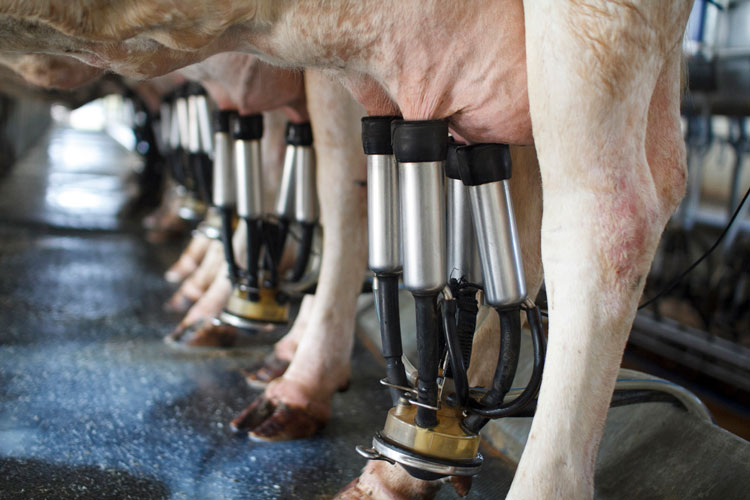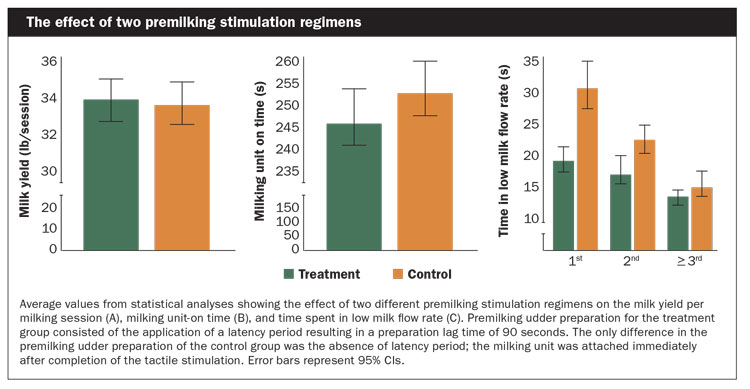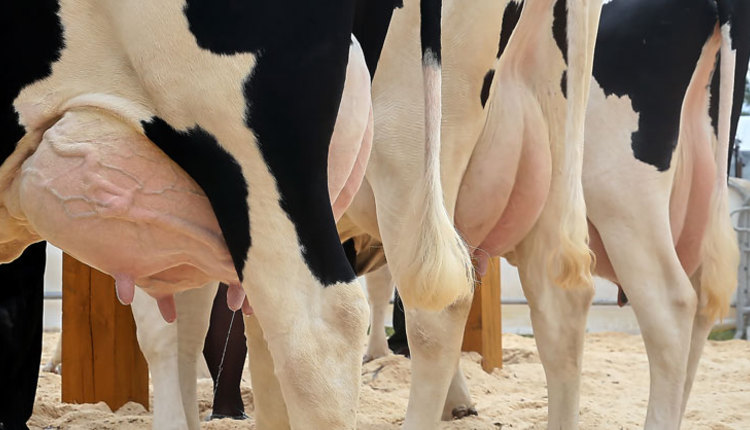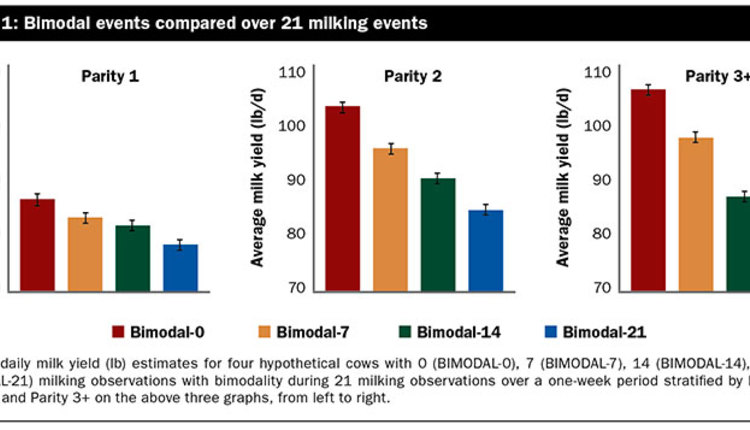
Here's the challenge: Cow milking routines are designed to facilitate a gentle, quick, and complete milk harvest. In addition, monitoring mammary health is essential to ensure a high-quality product and animal well-being.
Current recommendations for premilking udder preparation are teat sanitization (including premilking teat disinfection, cleaning, and drying of teats) and premilking stimulation. Premilking stimulation involves tactile stimulation and milking unit attachment delay. This includes the preparation lag time (the period from the first tactile stimulus to the attachment of milking unit) or latency period (the period after completion of tactile stimulation and before milking unit attachment). Premilking stimulation is essential for the establishment of the milk-ejection reflex to harvest the alveolar milk fraction, which can comprise up to 80% of the udder’s milk volume.
Don’t rush
From the perspective of practical milking management, a short latency period between udder preparation and the start of milking is advantageous because several animals can be prepared in a row before the clusters are attached. A short premilking stimulation of 15 seconds followed by a latency period of up to 1 minute can be equally efficient as continuous prestimulation.
Current industry recommendations suggest that a tactile teat stimulation of 10 to 20 seconds and an interval of 60 to 90 seconds between stimulation and milking unit attachment are sufficient to achieve efficient milk letdown and removal. These recommendations have been supported by several recent studies that have shown the beneficial effects of preparation lag time on the elicitation of the milk-ejection reflex and milking performance.
Despite these findings, the adoption of a milking routine that includes a sufficiently long preparation lag time has been implemented slowly. This is likely due to the growth in herd size and more reliance on hired labor, which demands greater focus on improving parlor throughput.
A study published by researchers from Michigan State University reported that the total stimulation time was reduced by half in larger herds (more than 300 cows) compared with that in smaller herds. Previous work from our own group also indicated that the preparation lag time applied in large dairy operations is as short as 57 seconds.

Improper preparation lag time may aggravate the impact of machine milking on teat tissue. In a recent observational study, we reported that a shorter preparation lag time was associated with greater odds of machine milking-induced short-term changes (STC) in teat tissue. STC can lead to more teat canal colonization, a higher risk of new intramammary infection, and a higher somatic cell count. In addition, STC is thought to reduce animal well-being.
The implementation of a milking regimen that includes a sufficiently long preparation lag time may mitigate these consequences. However, to the best of our knowledge, controlled studies investigating the cause-and-effect relationship between preparation lag time and STC in high-producing Holstein dairy cows milked three times per day are lacking. We, therefore, set out to investigate the effect of preparation lag time on STC. Our secondary objective was to study the effect of preparation lag time on milking performance.
The study design
In a randomized controlled study, 145 Holstein cows from our research herd with a 3x milking schedule were assigned to treatment or control groups. Premilking udder preparation for the treatment group consisted of predipping, sequential forestripping of two streams of milk per quarter, wiping of teats, a latency period, and attachment of the milking unit 90 seconds after initiation of the forestripping step. The only difference in the premilking udder preparation of the control group was the absence of a latency period between wiping and attachment.
We assessed STC by palpation and visual inspection postmilking. Electronic on-farm milk meters were used to evaluate milking characteristics: milk yield (kilograms per milking session), milking unit-on time (seconds), time spent in low milk flow rate (seconds), and bimodality (present versus absent). We used appropriate statistical methods to analyze the effect of treatment on the outcome variables.
What we found
We found that the risk of STCs was lower for cows that received a 90-second preparation lag time compared with cows in the control group [odds ratio (95% confidence interval) = 0.13 (0.08 to 0.20)]. Average values for milk yield of cows in the treatment and control groups were 33.9 and 33.7 pounds per milking session and 246 and 253 seconds for milking unit-on time, respectively.
The effect of treatment on time spent in low milk flow rate was modified by the effect of lactation number such that differences among groups were more pronounced in first-lactation animals compared with second and third and older lactation cows. The duration of time spent in low milk flow rate of first, second, and third or later lactation cows in the treatment group was 19, 17, and 13 seconds, respectively. For those in the control group, it was 31, 22, and 15 seconds (see figure).
We observed a similar relationship for bimodality such that differences in the odds of bimodality among treatments were larger for first-lactation animals compared with second and third and older lactation cows. Compared with cows in the control group, the odds of bimodality for first, second, and third and older lactation cows, respectively, were 0.19 (0.14 to 0.24), 0.29 (0.22 to 0.38), and 0.39 (0.28 to 0.53).
Cows that received a 90-second preparation lag time during premilking udder preparation had a lower risk of STC, shorter milking unit-on time, and spent less time below 2.2 pounds per minute milk flow rate to harvest the same amount of milk per milking session. Thus, a preparation lag time of 90 seconds coupled with forestripping and wiping of teats in premilking udder preparation provided more time to accommodate the cows’ physiological requirements for the elicitation of the milk-ejection reflex. This alleviated the negative effects of mechanical forces on the teat tissue during machine milking and has the potential to improve udder health and promote animal well-being.





